Northern Hardwood Forests of the Adirondacks
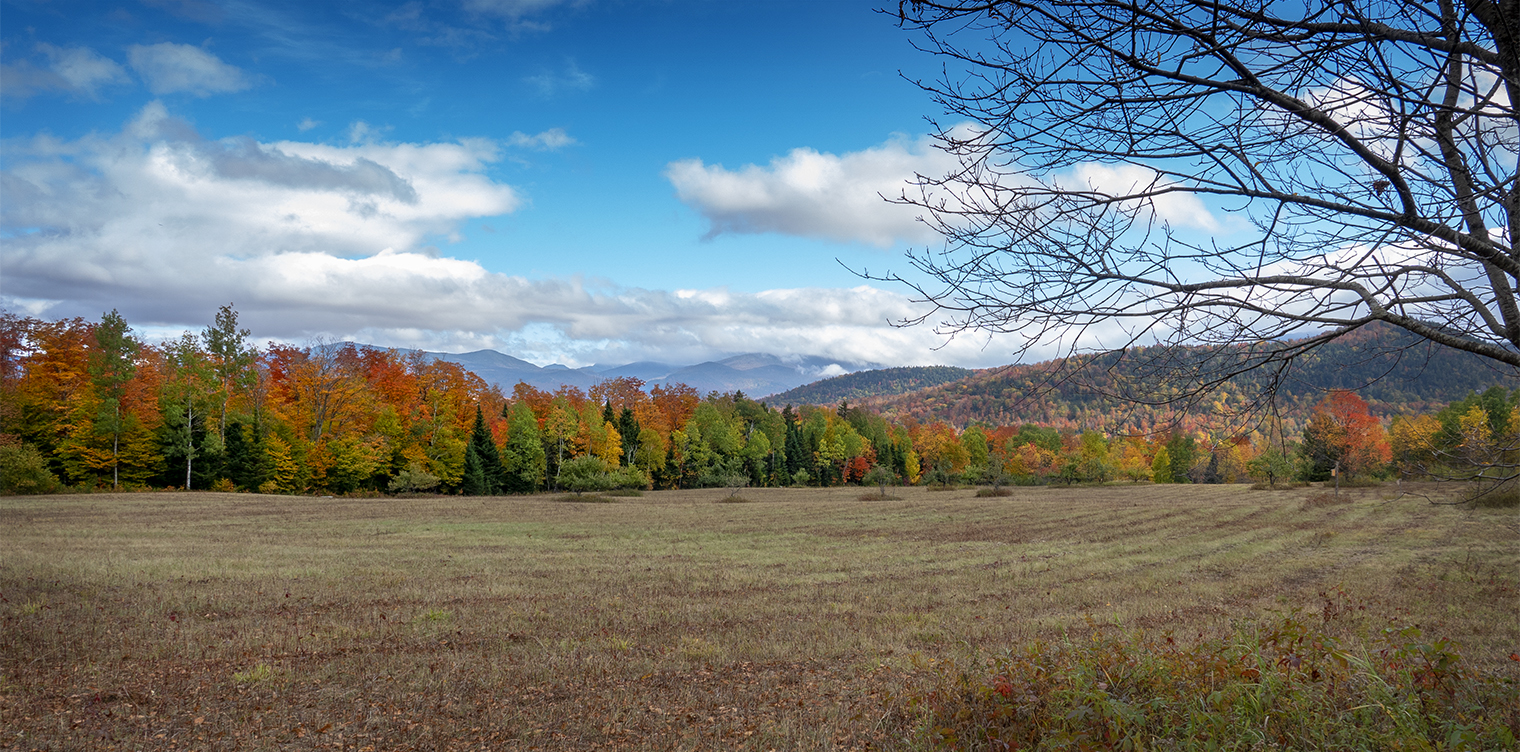
The northern hardwood forest is the most extensive woodland in the Adirondacks. It occupies the region's best soils and sites, growing on the more fertile soils that make up glacial till. The northern hardwood forest is generally found on the lower and warmer mountainsides – gentle slopes where soils are neither extremely dry nor extremely wet.
The most dominant life form in the northern hardwood forest are deciduous trees, which lose their leaves each fall and are almost completely dormant in the winter months. One of the most striking characteristics of the northern hardwood forest is the extravagant display of fall colors, which results from the loss of green pigment, chlorophyll, as the trees slow down their photosynthesis in the autumn and prepare to enter dormancy for the winter. With the chlorophyll gone, pigments which were hidden previously become visible, producing the vibrant reds of the Sugar Maple and the golden yellows of the American Beech.
Northern hardwood forests in the Adirondacks can be recognized from afar by the color and pattern of foliage.
- In spring, before leaf-out, the grey-brown pattern of unleafed branches contrasts with the somber dark green expanse of conifers both above and below the hardwoods.
- In summer, hardwood forests can be distinguished by areas of bright green foliage.
- In fall, the oranges, yellows, and reds of deciduous trees stand out against the dark greens of the conifers.
Trees of the Northern Hardwood Forest
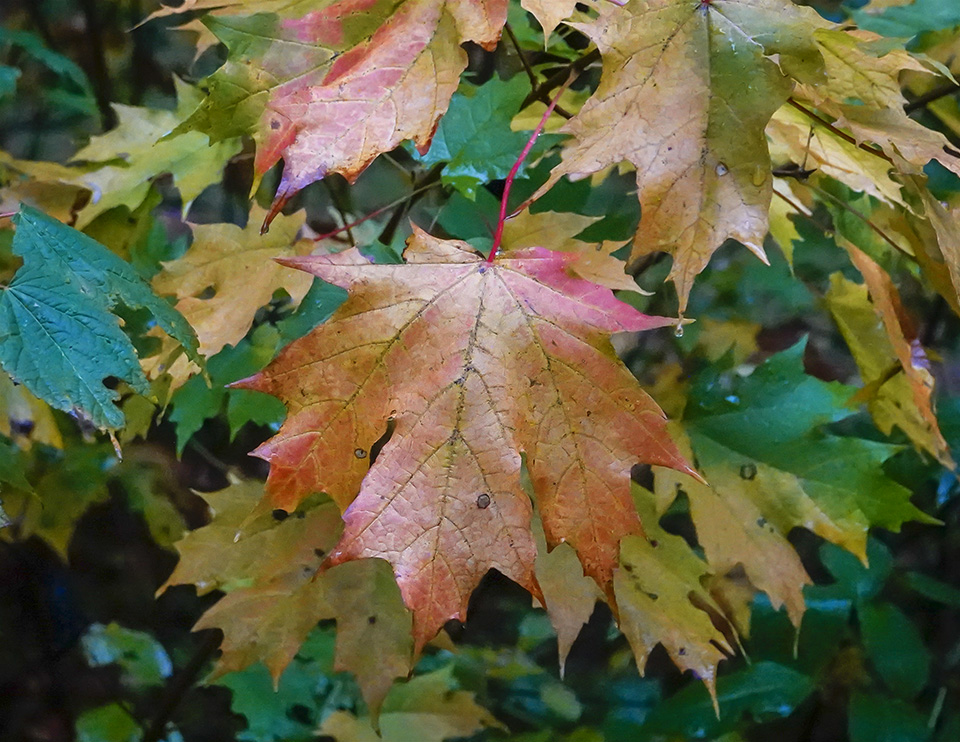
The two dominant tree species in the northern hardwood forest are Sugar Maple and American Beech, both of which can tolerate more shade than other hardwoods and thrive on deep, fertile, well-drained till. Also present in some areas is Yellow Birch, which requires somewhat more sun and does well on both till and outwash, and Eastern Hemlock. The mix of trees on any given site varies with the elevation, soil, topography, and water table.
The Sugar Maple – growing in abundance with Yellow Birch, Eastern Hemlock, American Beech, and Eastern White Pine – is an indicator species for the northern hardwood forest. On those areas most suited for hardwoods, Sugar Maple is the dominant species. This tree can also be found in mixed hardwood-conifer forests. Although the Sugar Maple grows in a wide variety of soils, it does best on deep, well-drained soils. It is rarely found in swamps, because it does not tolerate wet soils.
Sugar Maple is a food source for several wildlife species. White-tailed Deer, Moose, and Snowshoe Hares commonly browse on Sugar Maple trees. Red Squirrels feed on its seeds, buds, twigs, and leaves. Porcupines eat the bark and can girdle the upper stem. A number of birds build nests in Sugar Maples, including American Redstarts, Evening Grosbeaks, Baltimore Orioles, and Northern Cardinals. For several species – including the Cerulean Warbler, Scarlet Tanager, Hairy Woodpecker, and Summer Tanager – the Sugar Maple is one of the preferred trees for foraging for insects.
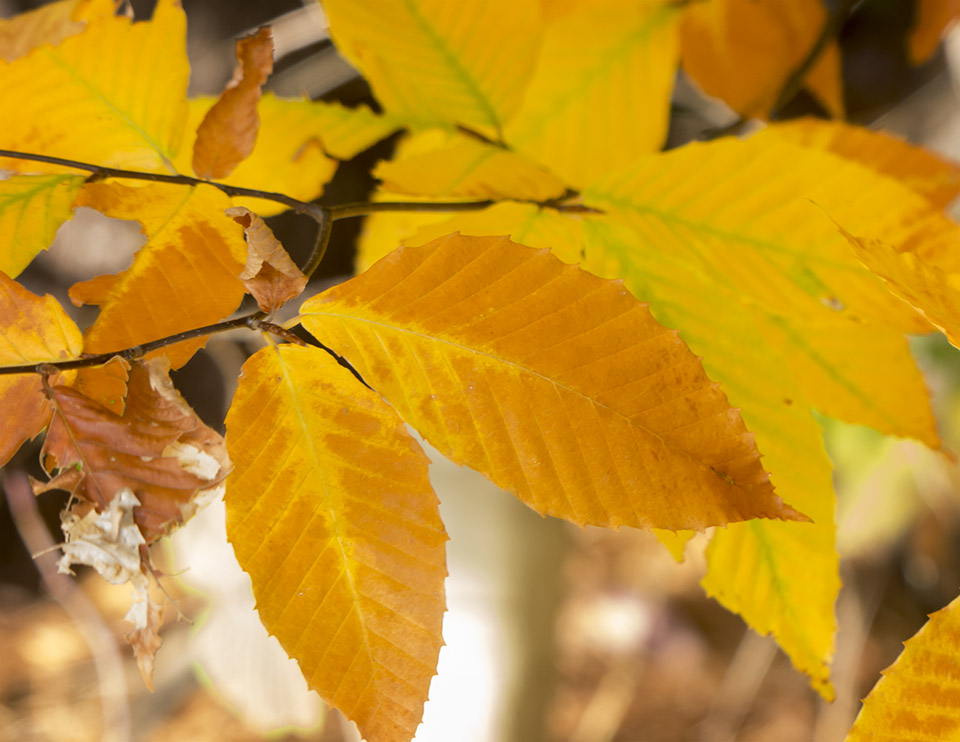
American Beech is the other dominant species in northern hardwood forests of the Adirondacks. It also occurs in mixed hardwoods with Sugar Maple, birch, and hemlock. American Beech trees do best in well-drained upland sites and are not found in wetlands. American Beech trees contribute to the brilliant fall color of the Adirondacks, turning golden yellow or lustrous brown in late September and October, then pale brown in autumn. The leaves remain on the tree well into winter.
Beech nuts are an important source of food for wildlife, including Raccoons, White-tailed Deer, Porcupines, and foxes, as well as squirrels and chipmunks. Beechnuts are also consumed by Black Bears, who load up on calories for winter hibernation. The American Beech also provides food and nesting sites for a variety of birds. American Beech trees are used as a nest site by Cooper's Hawks and American Redstarts. American Beech trees provide nest cavities for cavity nesters, like the Wood Duck. Beechnuts are an important food source for Blue Jays, Red-headed Woodpeckers, White-breasted Nuthatches, and Red-bellied Woodpeckers.
Shrubs of the Northern Hardwood Forest
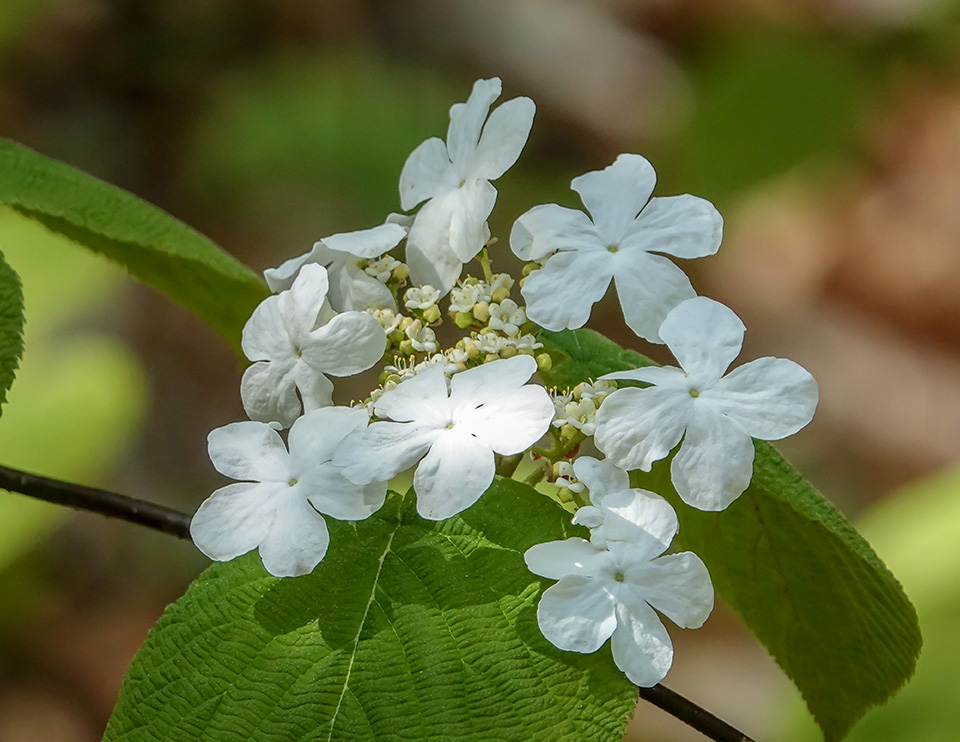
The understory of the northern hardwood forest includes several species of shrub:
Hobblebush, which also occurs commonly in mixed wood forests, is a native deciduous shrub which abounds in rich, moist woods throughout the Adirondack Mountains. It produces flat-topped clusters of fragrant white flowers in the spring. The flowers are followed in September by red berries gradually changing to dark blue, and attractive bronze-red or purple foliage in the fall. This shrub grows to a height of three to six feet. Hobblebush serves a variety of wildlife. Browsers eat its twigs and leaves. Game birds, songbirds, and mammals eat the fruit.
Another common understory plant is Striped Maple, an indicator species of the Northern Hardwood forest. It is a deciduous understory tree or large shrub which flourishes in cool, moist woods in the Adirondack Mountains. Striped Maple leaves turn yellow in the fall. These plants can also be found in mixed wood forests. The Striped Maple is an important browse plant for wildlife. Its twigs are browsed by Snowshoe Hares. Red Squirrels and Eastern Chipmunks eat the seeds. Striped Maple is frequently eaten by North American Porcupines. The Striped Maple also provides browse for White-tailed Deer and Moose. Striped Maple are also very useful to wildlife in that these understory plants help diversify the vertical profile of a forest, creating the dense layers in a woodland that are attractive to many wildlife species for nesting, feeding, and perching.
Wildflowers and Ferns of the Northern Hardwood Forest
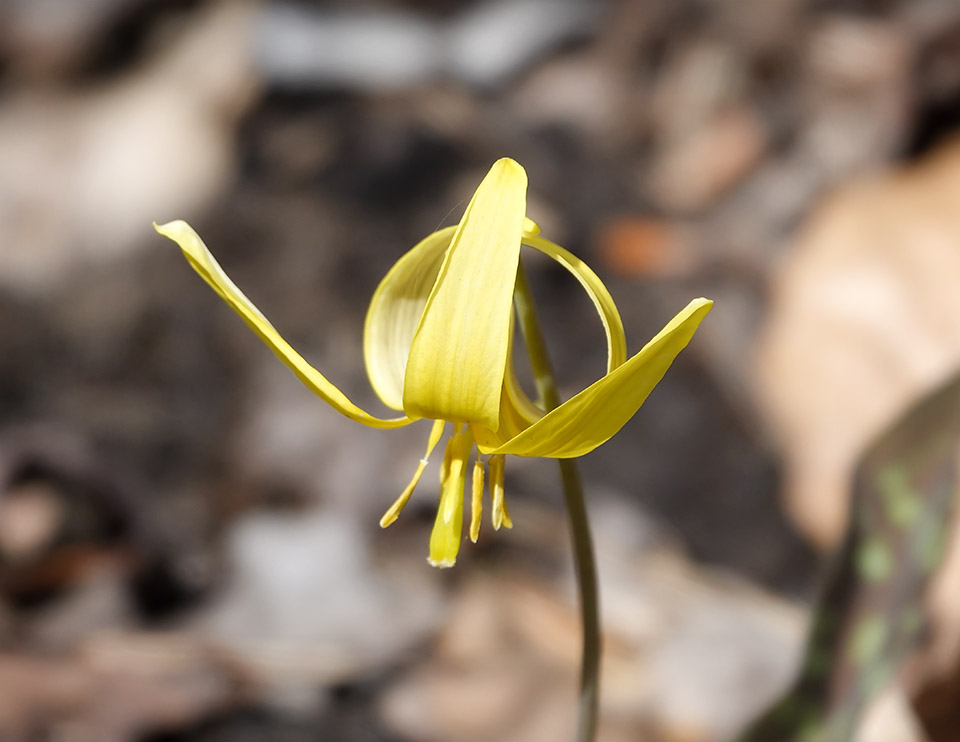
The wildflowers and ferns that flourish in the deeply-shaded forest floor of a mature northern hardwood forest are those that are very tolerant of shade. The only sun-loving wildflowers which bloom in a mature hardwood forest are found on the edges of wide trails or in places where a blowdown or other disturbance has created a gap in the tree canopy.
Northern hardwood forests are home to a group of spring-blooming wildflowers known as spring ephemerals. These are perennial woodland plants that sprout from the ground in deciduous forests in early each spring, then quickly bloom and seed before the canopy trees overhead leaf out. Once the leaves of the deciduous trees above are fully-developed and the forest floor is deep in shade, the foliage of these plants wither away leaving just the roots, rhizomes, and bulbs underground.
Spring ephemerals that bloom in the Adirondack Mountains include Trout Lily, Dutchman's Breeches, Squirrel Corn, Carolina Spring Beauty, and Dwarf Ginseng. You can also find many of these plants in mixed wood forests, but almost always under deciduous trees. These little plants emerge, bloom, and die back very quickly, sometimes (depending on the weather) in a matter of a few days, so nature lovers seeking to find them need to carefully time their spring wildflower walks.
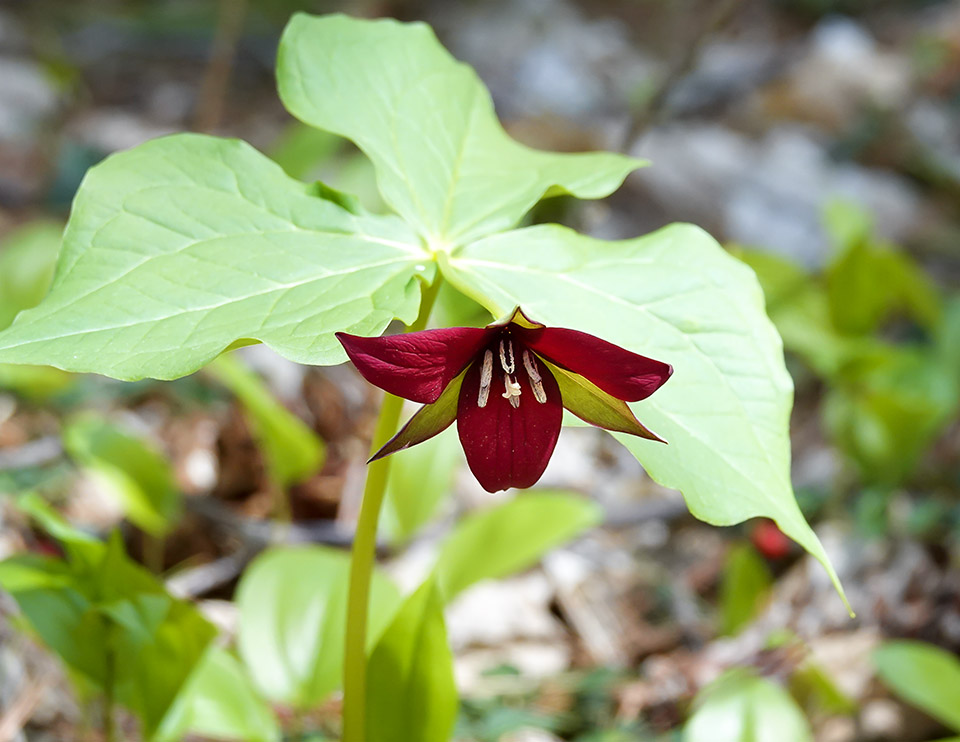
Other shade-tolerant wildflowers common in northern hardwood forests in our region include Purple Trillium, Indian Cucumber-root, Jack-in-the-Pulpit, Canada Mayflower, Starflower, and Wild Sarsaparilla. Most bloom in the spring, many in dappled sunlight before the leaves of the maples and beeches above have fully developed. Many of these plants may also be found in mixed wood forests, often in proximity to a group of deciduous trees.
Ferns – non-flowering, perennial plants that reproduce by spores – are an important component of the forest understory. Together with wildflowers, they form an intermediate layer between the understory and a litter layer of decomposing leaves and wood.
Ferns found in the northern hardwood forest include Northern Lady Fern, Bulbet Fern, Christmas Fern, Maidenhair Fern, Interrupted Fern, Hay-scented Fern, Intermediate Woodfern, and New York Fern. Two fern allies – Shining Clubmoss and Tree Clubmoss (or Ground Pine) – are also found in this habitat in abundance.
Wildlife of the Northern Hardwood Forest
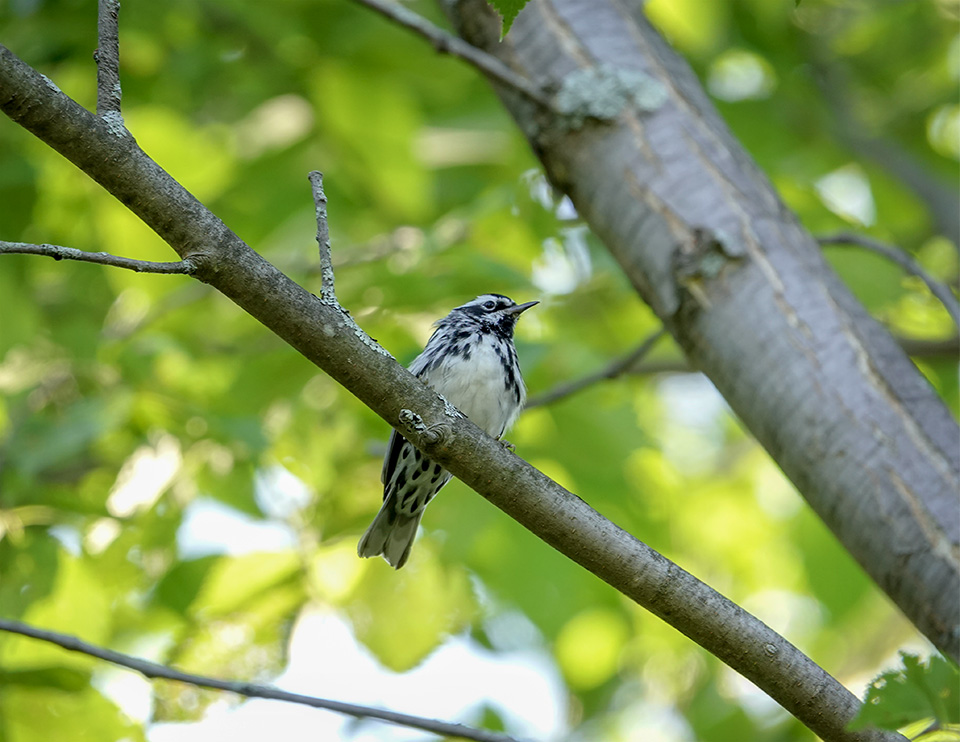
Birds that make their home in the northern hardwood forest of the Adirondack Mountains include year-round residents (primarily generalists like the Black-capped Chickadees, Common Ravens, and Downy Woodpeckers).
The list of birds that breed in northern hardwood forests also includes summer residents, such as Ovenbird, Wood Thrush, Red-eyed Vireo, Eastern Wood-Pewee, Black-and-white Warbler, Black-throated Blue Warbler, Veery, and Scarlet Tanager.
- Some summer residents who breed in the northern hardwood forest, such as the Ovenbird, favor mature forests.
- Other birds prefer successional forests – deciduous forests that are regenerating from natural or man-made disturbances. Examples include the Chestnut-sided Warbler (which breeds in early successional deciduous woods) and the Veery (which breeds in disturbed and successional northern hardwood forests).
Some of these summer migrants rely on the deciduous forest for both feeding and nesting sites. The Scarlet Tanager, for instance, prefers mature deciduous forest during breeding season and often nests in maple or beech. This bird commonly forages on three of the primary deciduous trees of the northern hardwood forest: Sugar Maple, American Beech, and Yellow Birch.
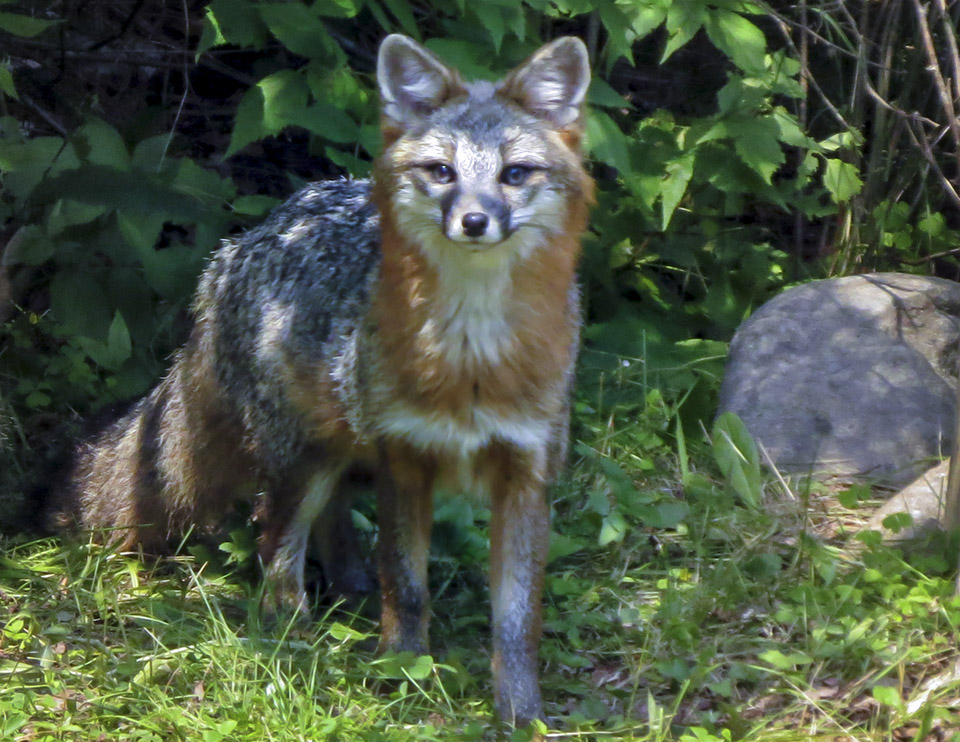
Characteristic mammals of the northern hardwood forest in the Adirondacks include the Eastern Chipmunk, Gray Squirrel (along the eastern and southern margins of the mountains), Southern Flying Squirrel, Gray Fox, Porcupine, Black Bear, Eastern Coyote, Striped Skunk, Fisher, Raccoon, Bobcat, and White-tailed Deer.
These species rely to varying degrees on deciduous trees as a vital food source. The Yellow Birch, for example, provides browse for White-tailed Deer. Moose, Eastern Cottontail, and Snowshoe Hare also use the plant for food. Red Squirrels cut and store the mature catkins of the birch and eat the seeds. American Beaver and North American Porcupine chew the bark.
Many of the mammal species who live in this habitat, like the Eastern Chipmunk, Gray Fox, and Fisher, can also be found in mixed wood forests. Others, like the White-tailed Deer, can also be found in farmlands and the brushy areas of successional fields.
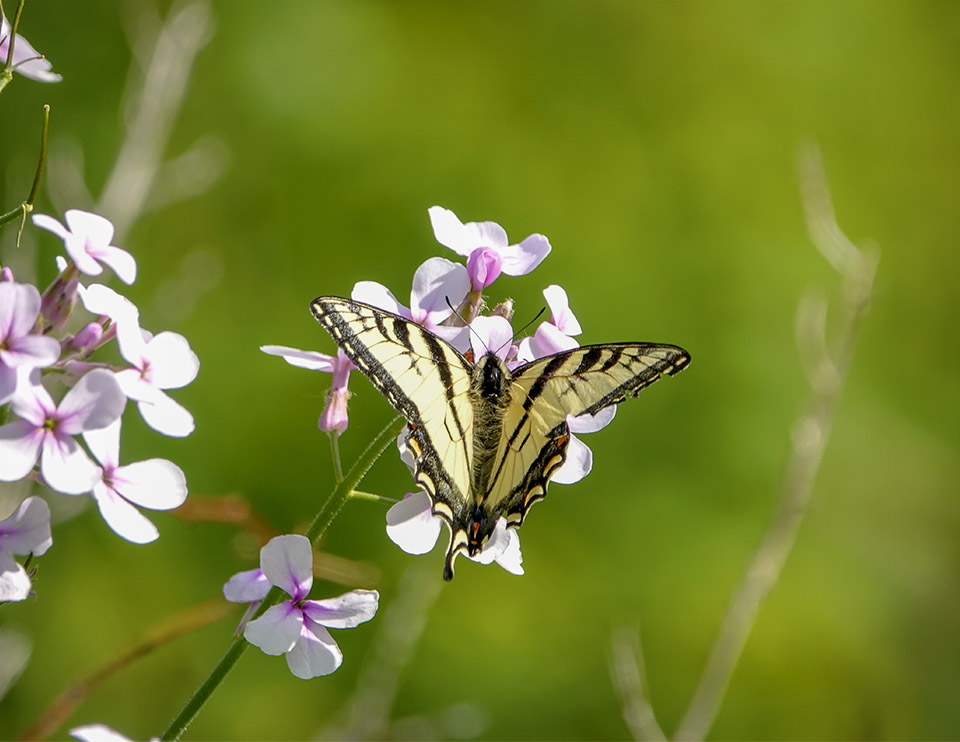
Some species of butterflies and moths make use of the northern hardwood forest in the Adirondack Mountains.
- Butterflies that use deciduous trees as their caterpillar hosts include the Eastern Comma, Spicebush Swallowtail, and Canadian Tiger Swallowtail.
- The Spotted Tussock Moth is usually found in boreal forests containing its host plants: deciduous trees. This small, attractive moth is usually seen in the Adirondack Mountains in June.
- One of our silkmoths, the Promethea Silkmoth, a large moth which may be seen in the Adirondack Mountains in upstate New York in late May and early June, also favors deciduous woodlands.
- The Luna Moth, a large nocturnal moth that may be seen in the Adirondacks in June, also lives in deciduous hardwood forests.
- The Rosy Maple Moth can also be found in hardwood forests; its preferred host is the maple.
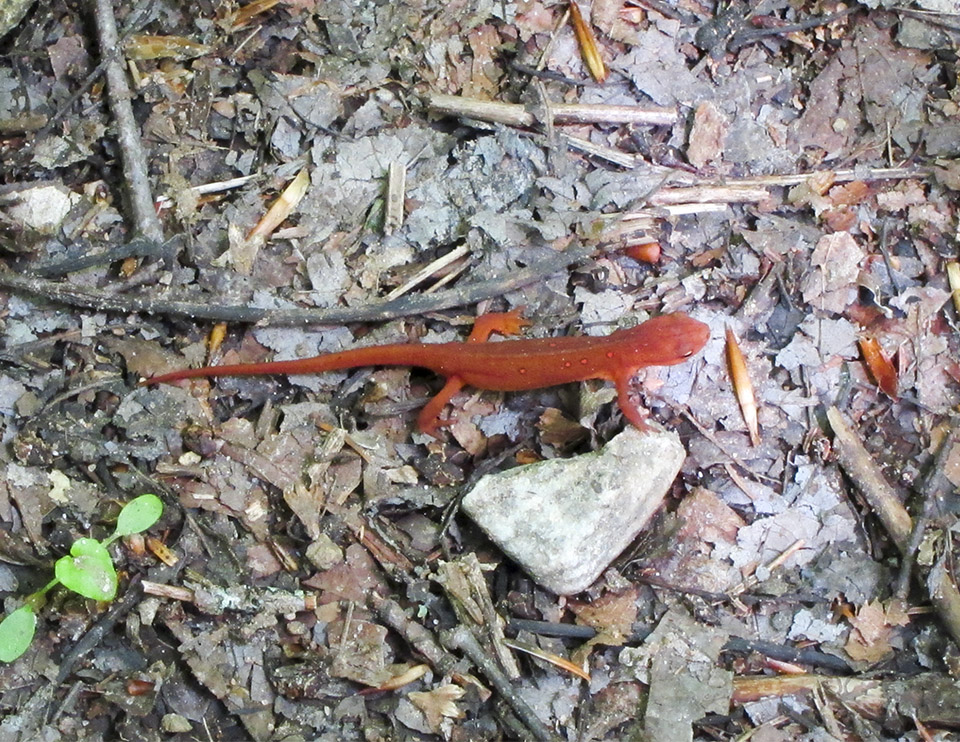
Amphibians and Reptiles of the Adirondack hardwood forest include the Eastern Newt, Spotted Salamander, Blue-spotted Salamander, Two-lined Salamander, Gray Treefrog, Wood Frog, American Toad, and Common Garter Snake. Some are generalists, like the Common Garter Snake, and are found in many terrestrial habitats.
The Eastern Newt only appears in this habitat during its terrestrial stage, when it is known as a Red Eft. These creatures begin life as eggs which hatch into aquatic larval newts, which then transform into brightly-colored Red Efts in their terrestrial stage. Red Efts spend several years on land. During the juvenile Red Eft stage, this amphibian is found on moist forest floors. Red Efts are typically found under leaf litter, brush piles, logs and stumps. They occur in forests of any type, but seem to prefer deciduous and mixed forests. Red Efts are mostly diurnal. Look for them in the leaf litter of the forest floor. The bright orange color warns predators of their toxic skin secretions. The eft later returns to water, transforming into aquatic adults.
References
James M. Ryan. Adirondack Wildlife: A Field Guide (University of New Hampshire Press, 2008), pp. 13-42.
D. Andrew Saunders. Adirondack Mammals (Adirondack Wildlife Program. State University of New York College of Environmental Sciences and Forestry, 1995).
William K. Chapman. Mammals of the Adirondacks: A Field Guide (Utica, New York: North Country Books, 1991).
William K. Chapman and Alan E. Bessette. Trees and Shrubs of the Adirondacks: A Field Guide (Utica, New York: North Country Books, 1990).
Alan E. Bessette et al. Birds of the Adirondacks: A Field Guide (Utica, New York: North Country Books, 1993).
Boughton Cobb et al. A Field Guide to Ferns and Their Related Families: Northeastern and Central North America (Houghton Miflin Company, 2005).
Jerry Jenkins. Climate Change in the Adirondacks: The Path to Sustainability (Cornell University Press, 2010), pp. 33-43.
Nancy G. Slack and Allison W. Bell. Adirondack Alpine Summits. An Ecological Field Guide (Adirondack Mountain Club, 2006), pp. 15-36.
E. H. Ketchledge. Forests and Trees of the Adirondack High Peaks Region (Adirondack Mountain Club, 1967), pp. 18-43, 96-101, 107-108, 129-131.
Michael Kudish. Adirondack Upland Flora: An Ecological Perspective (Saranac, New York: The Chauncy Press, 1992).
John Kricher. A Field Guide to Eastern Forests. North America (Boston: Houghton Mifflin, 1998), pp. 154-219.
Peter J. Marchand. Nature Guide to the Northern Forest. Exploring the Ecology of the Forests of New York, New Hampshire, Vermont, and Maine (Appalachian Mountain Club, 2010), pp. 13-18, 56-93.
John Kricher. Eastern Forests: A Field Guide to Birds, Mammals, Trees, Flowers, and More (Houghton Miflin Company, 1998).
Donald J. Leopold and Lytton John Musselman. Wildflowers of the Adirondacks (Johns Hopkins University Press, 2020), pp. 27-31.
Roger Conant and Joseph T. Collins. Reptiles and Amphibians. Eastern/Central North America (Houghton Mifflin Company, 1975).
Mark J. Twery et al. Changes in Abundance of Vascular Plants under Varying Silvicultural Systems at the Forest Ecosystem Research and Demonstration Area, Paul Smiths, New York. United State Department of Agriculture. Forest Service. Northern Research Station. Research Note NRS-169. 25 July 2012. Retrieved 18 January 2017.
Adirondack Park Agency. Natural Communities of the Adirondack Park. Retrieved 13 January 2017.
New York State Department of Environmental Conservation. New York Natural Heritage Program. Ecological Communities of New York State. Second Edition (March 2014). Retrieved 17 January 2017.
Elizabeth H. Thompson and Eric R. Sorenson. Wetland, Woodland, Wildland: A Guide to the Natural Communities of Vermont (University Press of New England, 2000), pp. 98-99, 129-137. Retrieved 23 April 2020.
Cornell Lab of Ornithology. All About Birds. Retrieved 17 January 2017.
Birds of North America. Subscription web site. Retrieved 20 January 2017.
Adirondack Ecological Center. Adirondack Birds. Retrieved 20 January 2017.
Audubon New York. Common Birds of New York Northern Hardwood Forests. Retrieved 28 December 2018.
Adirondack Ecological Center. Adirondack Amphibians and Reptiles. Retrieved 20 January 2017.
Butterflies and Moths of North America. Retrieved 17 January 2017.
University of Michigan. Animal Diversity Web. Retrieved 22 January 2017.
Vermont Fish & Wildlife Department. Northern Hardwood Forest Formation: Forests of Widespread Distribution in Vermont’s Moderate Climate Areas. Retrieved 17 January 2017.
Tom Kalinowski, "Adirondack Salamanders: The Red-Spotted Newt," Adirondack Almanack, 29 September 2014 Retrieved 17 January 2017.
